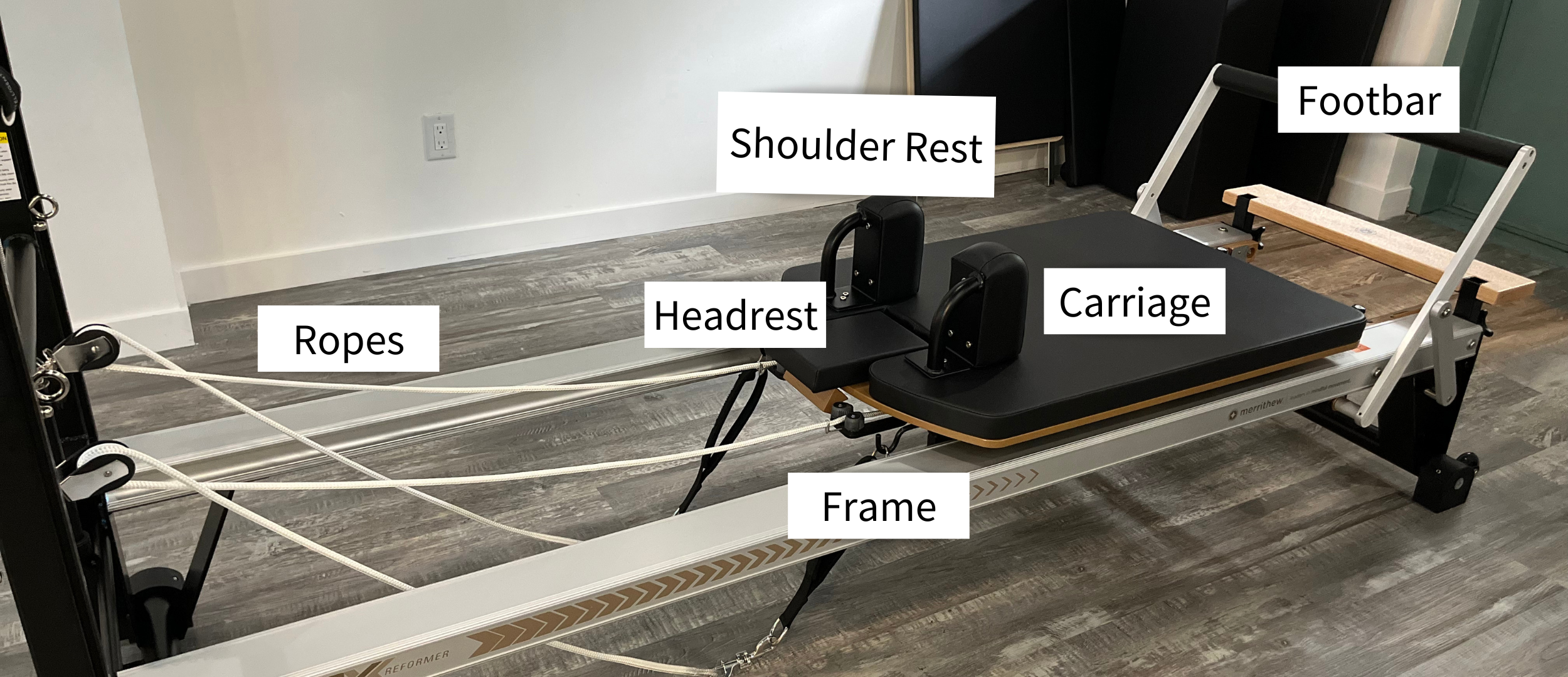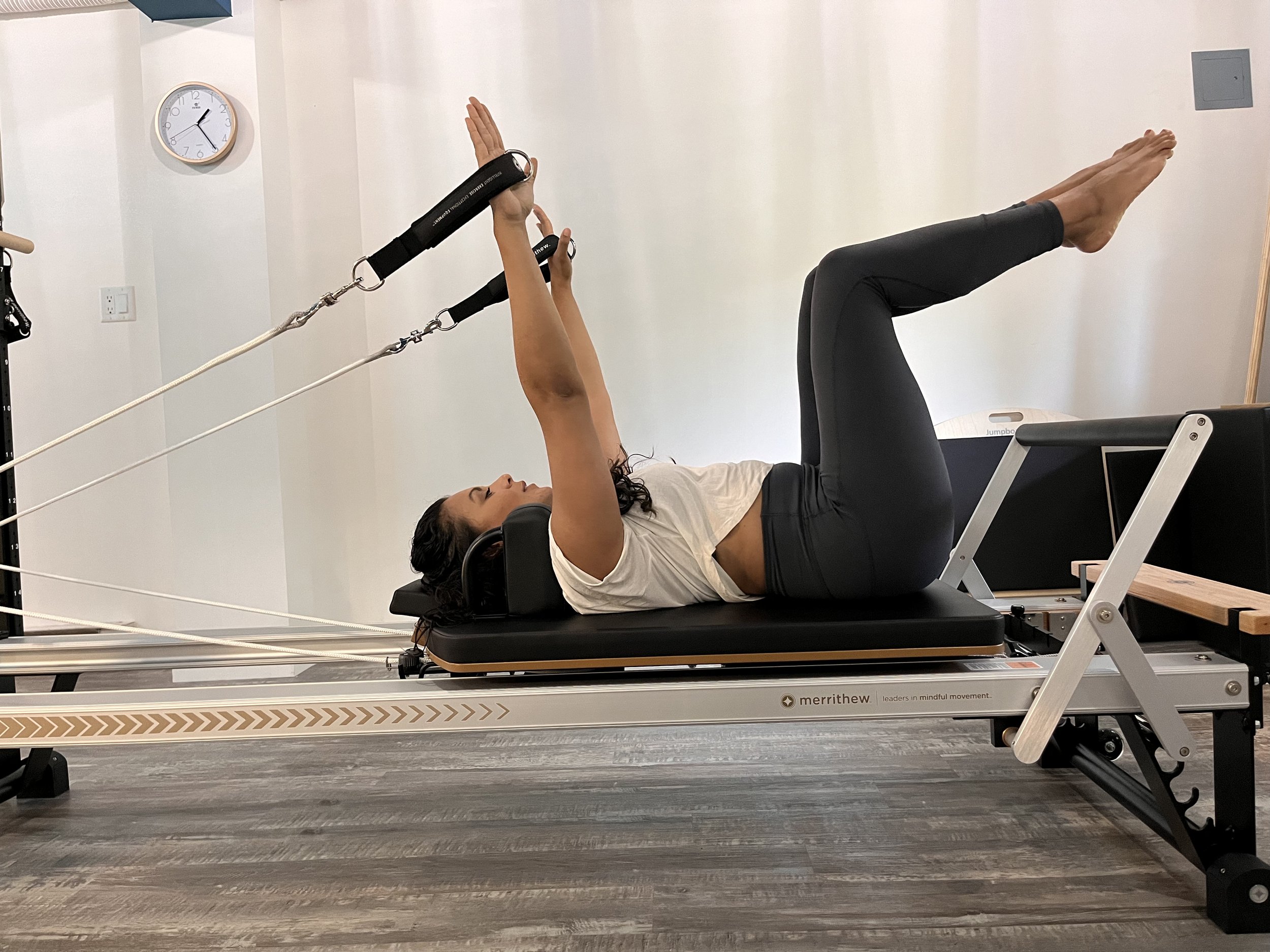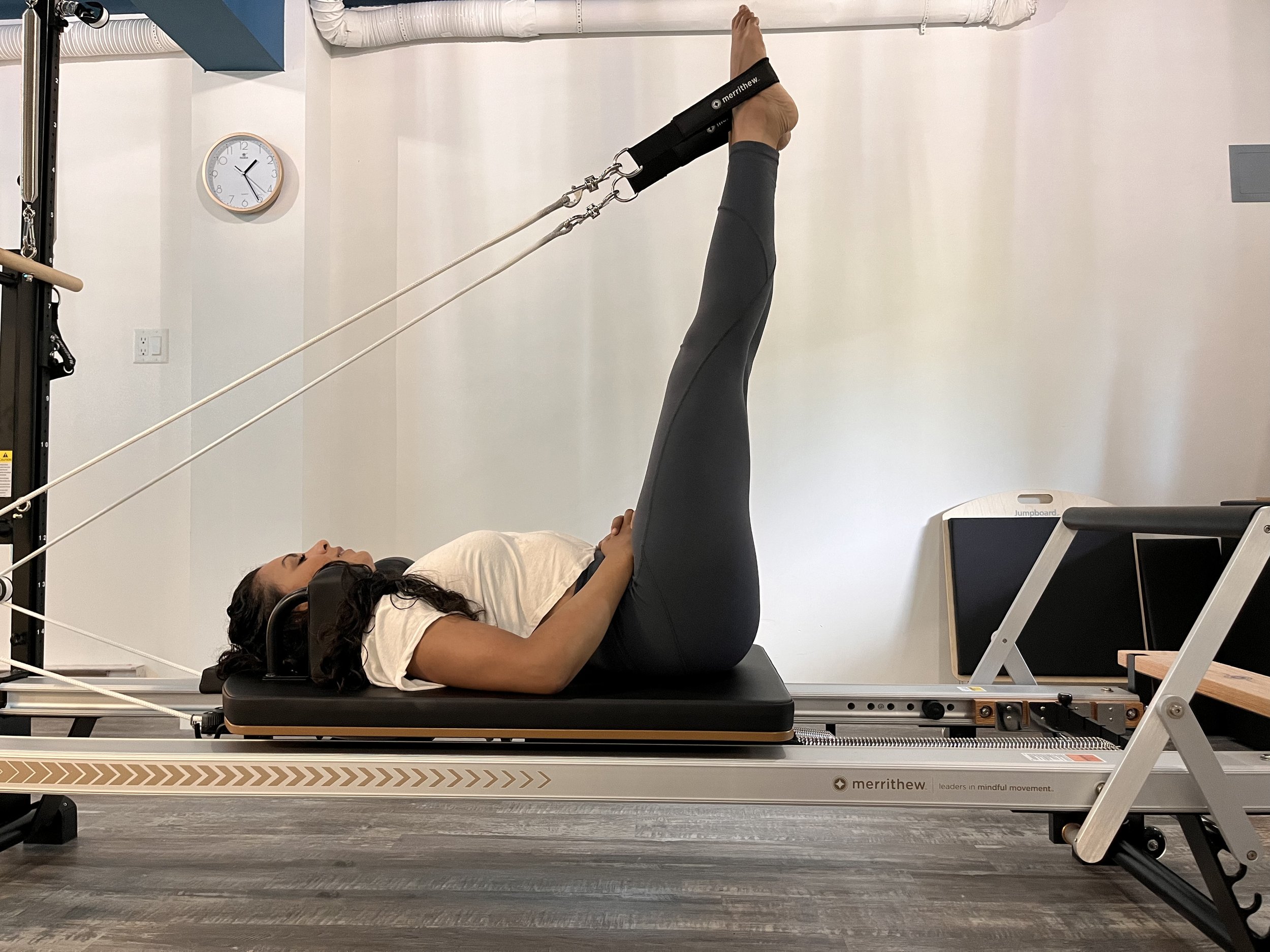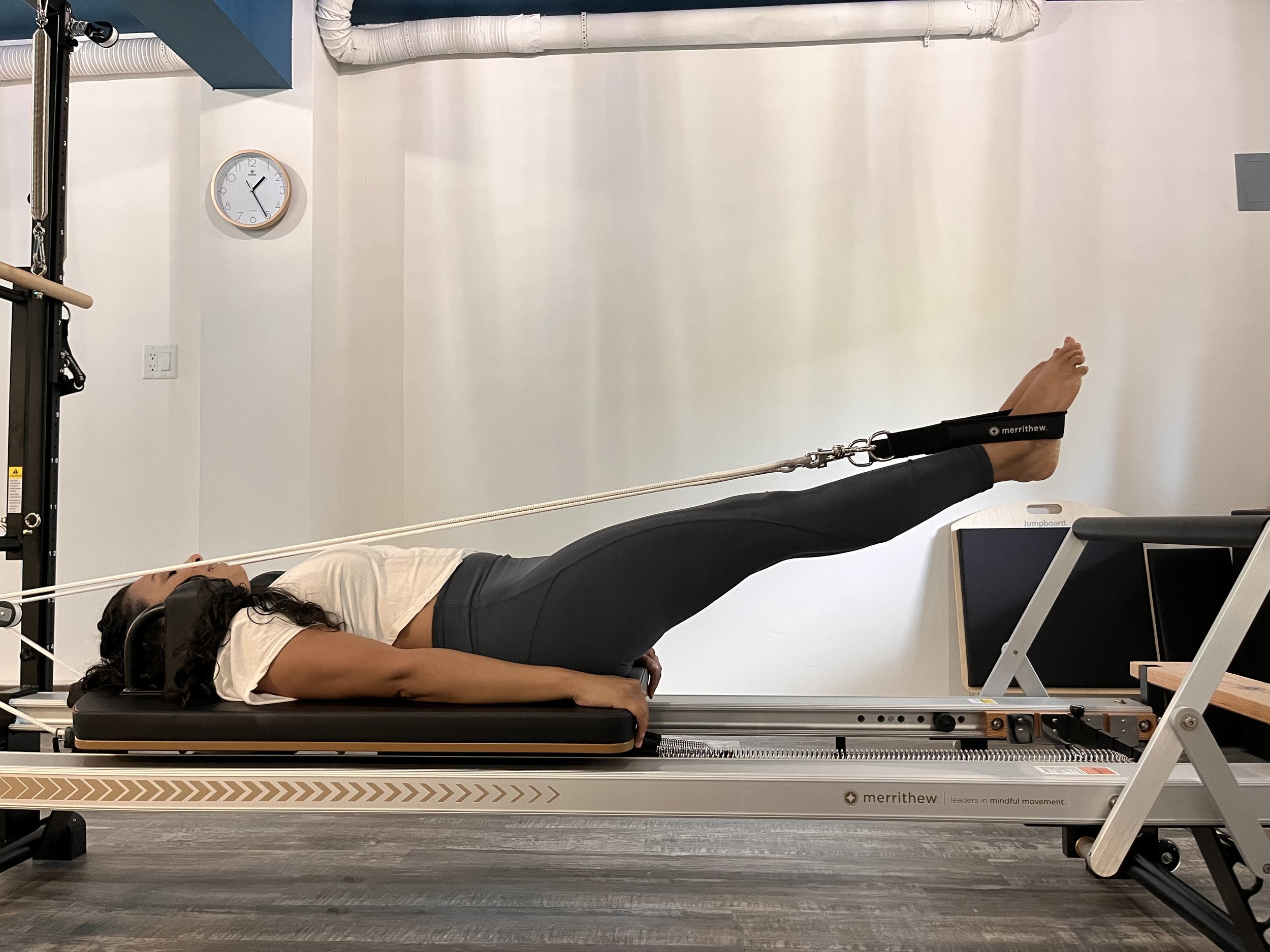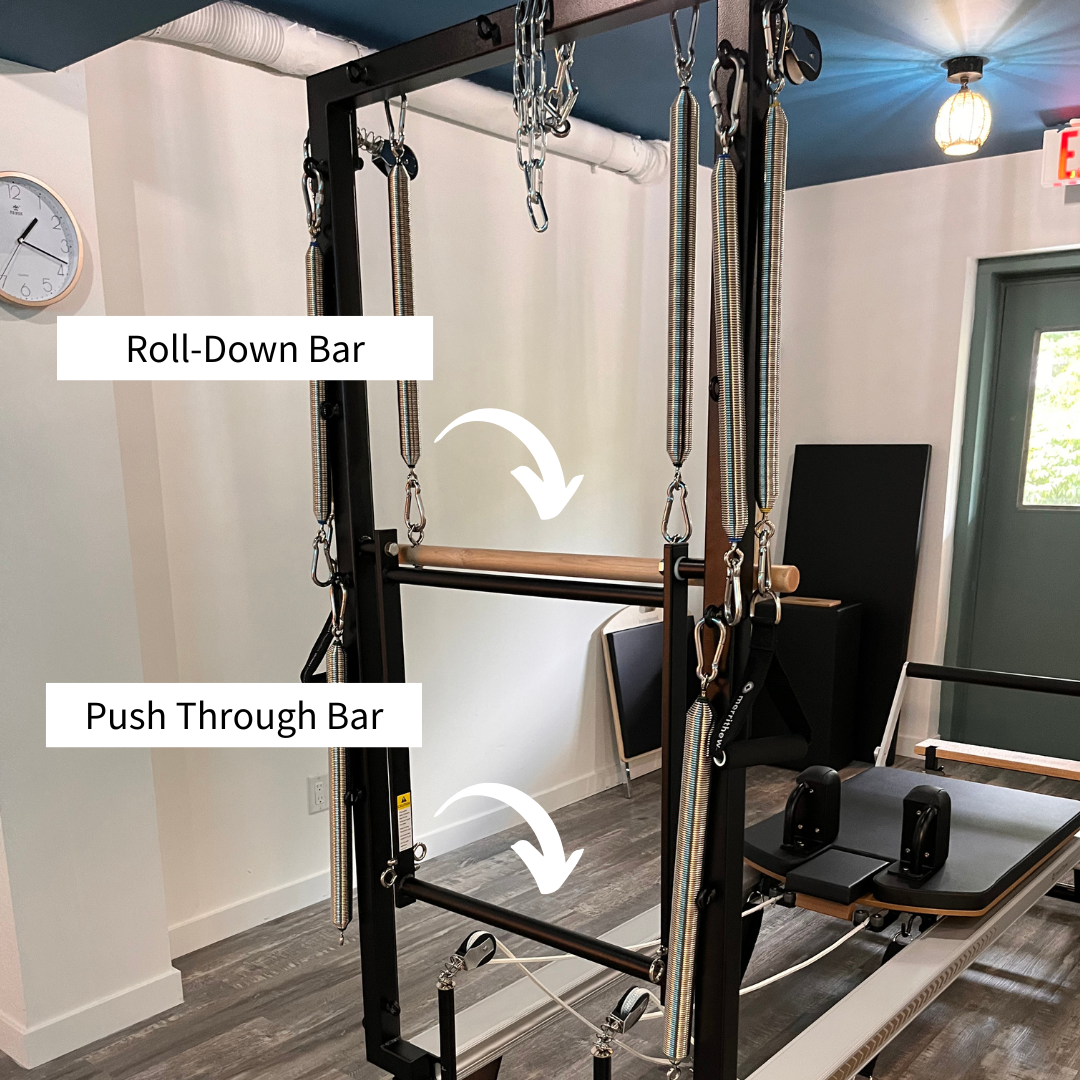FreeForm Physio & Pilates now has a reformer. “But what is it?” you ask. A question I hear often and a somewhat difficult one to answer without showing you.
After reading this blog, you will understand what a reformer is, and the endless benefits of this form of rehabilitation.
What the heck is a reformer?
To truly understand what it is, you really do have to see it! The picture below shows the reformer I have at my clinic, with a tower attachment at the back. Now, your first reaction might be, “Wow this looks like a torture device,” and you might be partly right ;)
Watch this quick video to learn more about a Pilates reformer.
The 6 Parts of a Reformer
To help give you an idea, here is a description of the different parts and the mechanics of the machine.
A rigid frame made out of wood or aluminium
A carriage or moving platform
Springs that extend from under the carriage (color-coded to indicate various tensions); a spring bar which is a part of the frame and is the piece to which the springs attach
Adjustable headrest and removable shoulder rests on the carriage
Adjustable foot bar at one end of the frame (you can push against the foot bar with your feet or hands in order to move the carriage)
Adjustable ropes that extend from under the carriage and go through two pulleys at the end of the frame, opposite the foot bar (you can place your hands or feet in straps at the ends of these ropes to move the carriage)
So How Does a Reformer Work?
The carriage moves within the frame against a little or a lot of tension produced by the number and colour of springs used. Spring tension is unique in that resistance increases as the spring is further tensioned, resulting in a muscle being challenged throughout its full range of motion. With normal weighted resistance like dumbbells, etc., the resistance remains constant throughout the range of motion; however, the muscle effort requires changes according to varying angles of the joint.
Reformer Exercises Showcasing the Core Features of the Reformer
Now that you know the parts of the Reformer, let’s look at a few examples of how it can be used in rehabilitation. The possibilities are endless, but here are a couple of positions and movements to give you a better understanding.
Foot Bar Exercises
Reformer “footwork” is an excellent introductory exercise on this apparatus.
This exercise is performed lying on your back, head supported on the headrest, shoulders against the shoulder rests with feet on the foot bar. Perhaps you have suffered an ankle or knee injury, you can perform a leg press movement against the foot bar in various foot positions (parallel forefoot, parallel heels, v-position of feet with either heels or forefoot on the bar, etc.) focusing on foot/knee alignment, stability, range of motion and strength. Or perhaps you struggle with lumbo-pelvic awareness and alignment during lower extremity movement like a squat. You can perform this same exercise focusing on pelvic stability, for instance, preventing a posterior pelvic tilt or “butt wink” as you begin to push from the foot bar or upon returning to the foot bar. For either area of focus, lighter springs will require more awareness and control, and more springs will provide greater feedback, but also require more strength.
Rope Based Exercises
Now that you have seen how the carriage moves within the frame via the foot bar, let’s introduce the ropes.
You can set yourself up in the same position on your back, feet floating above the foot bar or resting lightly on the foot bar, and performing arm movements or alternatively, you can have your arms down by your side and your feet in the straps moving through your hips and knees. Regardless of whether your feet or hands are in the straps, a higher spring tension will require more work for the extremities, and a lower spring tension will require more core strength. Determining spring tension always depends on the injury and goal of the exercise.
You can perform exercises on a reformer in a variety of positions, not just lying on your back.
For example, you can move onto your hands and knees, facing towards or away from the foot bar, performing different weight-bearing gluteal and core exercises such as plank and bird dog variations.
You can also do standing work on or beside the Reformer.
For example, a number of lunge variations can be performed either standing beside the Reformer and pushing the carriage back with one leg, or standing on the Reformer itself, one leg resting on the frame and one leg resting on the moving carriage either facing towards or away from the foot bar depending on where you want the resistance to come from.
Rehabilitation Benefits of using a Reformer
I hope these examples helped to show all the many ways in which a reformer can be used as part of your rehabilitation. To summarize, the reformer (Samantha Wood, 2018):
Provides both stable and moving surface options
Provides extreme adjustability (all movements can be adjusted based on patient size and limitations)
Creates both support and resistance
Teaches awareness and balance in addition to strength and flexibility
Allows for different orientations to gravity (lying on back or stomach, kneeling, seated, quadruped)
The ability to remove gravity from the equation allows for earlier progressive load bearing and the introduction of functional movements sooner in the rehabilitation process, without stressing the injured area
Spring tension can be released relieving joint compression or pressure on a muscle for acute injuries
Springs can be easily adapted to mimic a variety of activities and therefore be more functional
It also enables both the client and instructor to observe alignment and muscular patterning.
A FreeForm Fun Addition - A Tower Attachment
There is a tower attachment at the back of my reformer.
There are a few exercises you can perform using the moving carriage and tower together, but there are even more possibilities if you put in a flat mat insert into the frame between the carriage and foot bar. This insert essentially changes the Reformer into a lifted mat. This tower unit is basically a scaled-down version of Joseph Pilates' creation called the Cadillac.
The tower consists of 4 parts:
Metal frame
Springs of various tensions - lighter springs for arm work, heavier springs for leg work
A push-through bar - a strong swinging metal bar that can be attached by springs from above most often for assistance or attached by springs from below for resistance during exercise; the swinging bar can be used on the inside or outside of the tower frame
A roll-down bar - a wooden bar on springs that hooks to eyelets on the frame of the tower
The tower allows you to use individual springs for extremity work, which helps to easily identify asymmetries in the body, more so than the Reformer. The push-through and roll-down bars provide numerous core and spinal oriented exercises in addition to extremity work.
The Rehabilitation Benefits of the Tower Attachment
To summarize, the benefits of using the tower overlap with those listed above for the reformer with the added benefits of:
Providing a stable base which can be less intimidating than the reformer with its moving parts, and beneficial to those who suffer from post-concussion syndrome, dizziness, etc.
Because of the multiple options for spring attachments, it can challenge the body in multiple planes of motion and fuller movements than the reformer
The 4 Reasons Why I Love Using a Pilates apparatus
I discover much more about a person’s body moving on the machine than with them lying on a table, or even observing them standing with movement; on the reformer movement can be slowed and broken down into components with less effort required, allowing for a more thorough assessment
There are SO many options to make movements functional and more accessible to clients rehabilitating from an injury
It creates the ability to perform multiple repetitions with as little to as much load as tolerable for the client
The main reason I think this tool is so invaluable is that it provides the “AHA” moments - the feedback from this machine is incredible, and it often just takes a few repetitions of an exercise for a client to begin to understand and apply what they learned to whatever movement they had difficulty with originally
Summary
So that’s the description of the Pilates reformer with the tower attachment. I hope this helps you understand what Pilates equipment can offer and gets you excited to give it a try. Come down to my Squamish Pilates clinic for a demonstration.
Work Cited/Resources
Wood, Samantha. (2018). Pilates for Rehabilitation. Recover from injury and optimize function. Champaign, IL. Human Kinetics.


